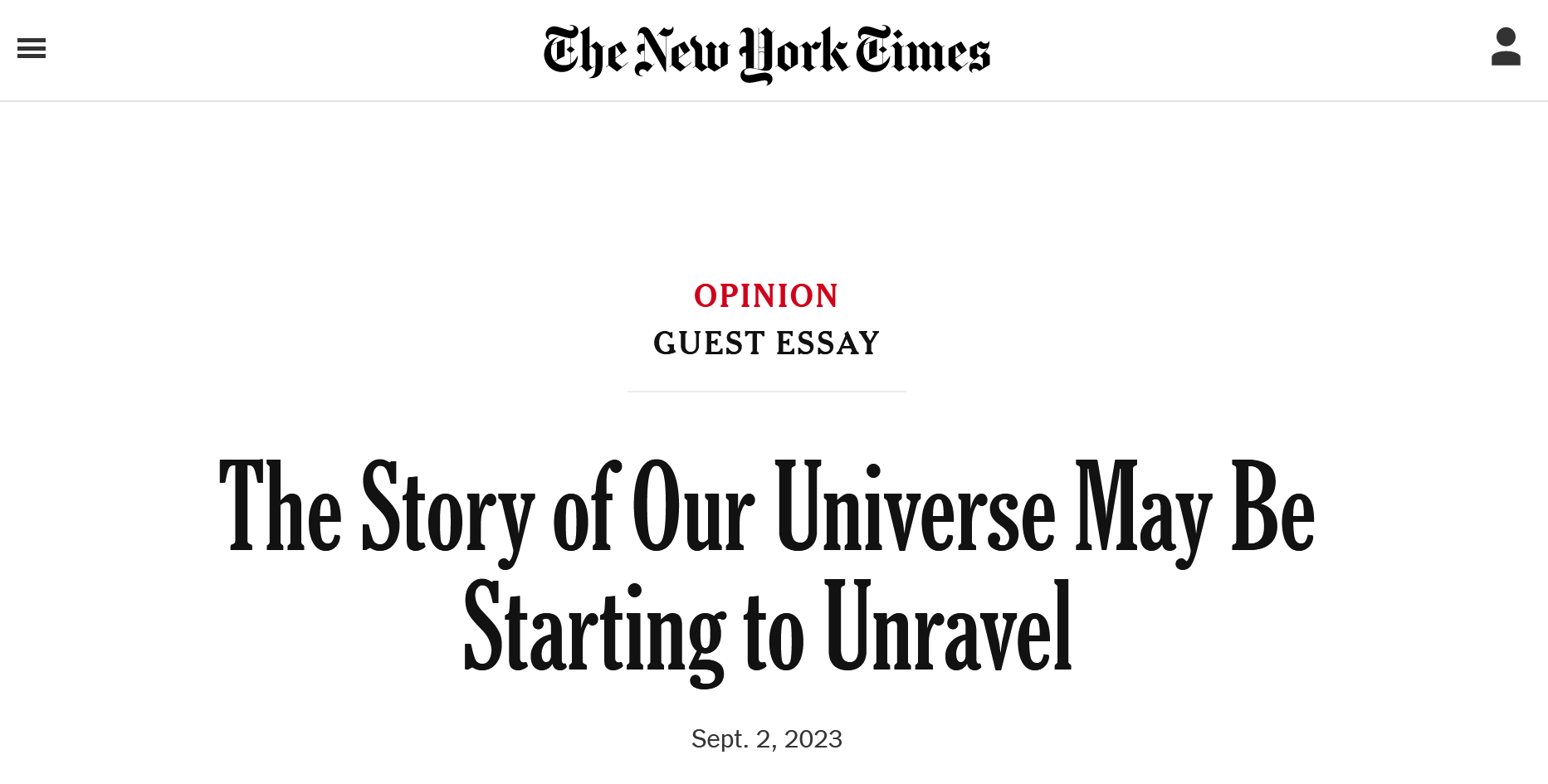New York, US. 6th September 2023 - Recently, an article titled “The story of our Universe may be starting to unravel” appeared in the international edition of New York Times (NYT), which highlighted the ‘crisis in cosmology’ unraveled by the James Webb Space telescope (JWST). One of JWST’s first major findings is very uncomfortable for astronomers: it discovered the existence of fully formed galaxies far earlier than should have been possible according to presently accepted, standard model of cosmology. Reacting to the NYT article, Mr. Subhajit Waugh, a scientist (physicist) working in RRCAT (Raja Ramanna Centre for Advanced Technology), said that the authors of the article have not realized that it could have been a much more newsworthy article (even though it was newsworthy enough to appear in NYT). Mr. Waugh asserted that the article is just the tip of the invisible iceberg. Not only cosmology is in crisis; physics faces severe crisis too (the two pillars of physics are bitterly conflicting), and the NYT article authors have failed to see the link. James Webb telescope can absolutely revolutionize science (especially physics and cosmology) and usher the greatest ever paradigm shift in science. Mr. Subhajit asserted that two next generation telescopes (the European Euclid and Japanese XRISM X-Ray telescopes) are just about to do that. James Webb might still triumph over both telescopes; but time is running out fast.
Mr. Waugh warned that if American scientific communities do not seize the opportunity to turn science upside down by following JWST’s startling revelations, then Europe will win the race, and Europe will be the leader of another scientific revolution. Or else, Japan, the 'land of the rising sun', will soon become the 'rising sun' in Science.
The NYT article wrote: “Physicists and astronomers are starting to get the sense that something may be really wrong. It’s not just that some of us believe we might have to rethink the standard model of cosmology; we might also have to change the way we think about some of the most basic features of our universe - a conceptual revolution that would have implications far beyond the world of science.” Mr. Waugh wholeheartedly agrees with the above paragraph. He agrees enthusiastically with another paragraph as well “We may be at a point where we need a radical departure from the standard model, one that may even require us to change how we think of the elemental components of the universe, possibly even the nature of space and time.” Mr. Waugh could not hide his joy and excitement when another paragraph was mentioned “But a (scientific) revolution may end up being the best path to progress. That has certainly been the case in the past with scientific breakthroughs like Copernicus’s heliocentrism, Darwin’s theory of evolution and Einstein’s relativity. All three of those theories also ended up having enormous cultural influence - threatening our sense of our special place in the cosmos, challenging our intuition that we were fundamentally different than other animals, upending our faith in common sense ideas about the flow of time.”
But when asked to elaborate, he simply smiled and said “You cannot run the 'Tokaido Shinkansen' bullet train on tracks built for steam locomotives. Similarly, you cannot run modern science on a century-old concept of SpaceTime.” He added “SpaceTime is the arena in which everything happens. It is the very fabric of reality. If you get that concept wrong, you are utterly lost and directionless.”
Mr. Waugh summarized: Physics is derailed (Ref. 1) and cosmology is in crisis (Ref. 2). Our concept of SpaceTime is faulty (Ref. 3, 4) and our mathematics is shaky (Ref. 5, 6). We are wrong about shape and size of the universe (Ref. 7). A tsunami sized ‘scientific revolution’ is coming (Ref. 8, 9, 10).
REFERENCE
Ref. 1 (A): Physicist congratulates ‘International Physics Olympiad’ awardees, and urges them to rescue Physics from present crisis
Ref. 1 (B): World's largest physics conference in Las Vegas will be grand; but will it be worthwhile?
Ref. 2 (A): Six major cracks have appeared in the standard model of cosmology. Is it wrong?
Ref. 2 (B): Shape and size of our universe: challenging the Standard Model of Cosmology
Ref. 3: The biggest mistake in Science: Space and Time do not fuse into SpaceTime continuum.
Ref. 4: Time itself is not the fourth dimension, but emerges due to motion along fourth space dimension
Ref. 5: Science is standing on shaky mathematical pillars, which guarantees a scientific revolution
Ref. 6: RRCAT Physicist Claims Correct Representation of Imaginary Numbers May Unify General Relativity and Quantum Mechanics
Ref. 7: We are wrong about the shape and size of our universe: RRCAT Physicist provides a new model of universe.
Ref. 8: Euclid telescope will revolutionize science, overthrow ruling scientific theories, and usher paradigm shift in science.
Ref. 9: Europe’s Euclid telescope can beat NASA’s James Webb telescope, making Europe the leader of another scientific revolution.
Ref. 10: Scientist predicts Japan, the 'land of the rising sun', will soon become the 'rising sun' in X-ray astronomy



